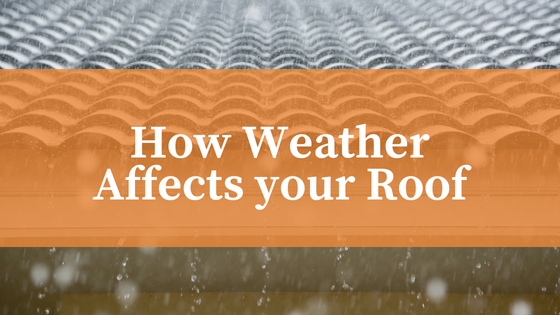How Weather Affects your Roof

Your home’s roofing system is its first line of defense against different weather elements such as hail, high winds, and snow. Storms pose the highest risk of damage to your roof and you cannot do much to prepare for it. If your roof is left unrepaired after storm damage, it can lead to a bigger mess and you might need to replace the entire roof.
Hail
Hailstorms often leave evidence behind in their aftermath. So how will you know what damage a hailstorm has done to your roof? Hail can generate small fractures in the roofing shingle regardless of the roofing material you used and this can weaken the entire roof. This can cause larger tears and cracks in the roofing over time. Additionally, depending on the storm’s intensity and the size of the hail, some sections of your roof may have been weakened in the process. You can catch this before it becomes any more problematic by ensuring you choose a durable and strong roofing material for your home and calling a professional to inspect after a hailstorm.
Wind
When a roof encounters high winds or a windstorm, this can loosen the tiny shingle granules that work to keep water out. Your roof could also end up missing a few shingles after a windstorm leaving your roof more vulnerable to weather elements.
Rain
Your roof is exposed to rain regularly, which can take a toll on it after some time particularly if you factor in other weather events such as hail or wind. Check the roof after a major rainstorm or thunderstorm and be more observant of your home. If you notice any fungus or mold on your roof or in your home or that your heating costs have become higher than usual, this could indicate roof damage.
Snow
When dealing with snowy roofs, the biggest problem to look out for would be ice dams. These are large ice ridges forming at the edge of gutters or a roof and they prevent any melting snow from running off your roof. When this water is unable to run off the roof, it may back up causing leaks in your roof. Ensure you remove the snow from your roof after every snow storm to remove one of the components required for these ice dams. If you find that you already have these ice dams, avoid hacking at them as you run the risk of damaging your roof even further. Call a professional to come and conduct a steam removal as an effective, quieter, and less-damaging way to solve this.
Trees
Trees might not be weather elements but they can also be damaging to your roof during certain weather events. If there is a tree with its branches touching or hanging over your roof, then they can poke holes in your roof shingles and rub the small shingle granules during a storm. You can sort this out by pruning back these branches or having a professional do it for you.

In Awe Roofing Limited is an Award-Winning, family owned and operated Vancouver Roofing Contractor with over 17 years of roofing experience. We serve the entire Lower Mainland area, from Whistler to Chilliwack, employing a team of professional staff members. Our team has won numerous awards including Best of Homestars for the last five years, and Three Best Rated six years in a row. Learn more






















